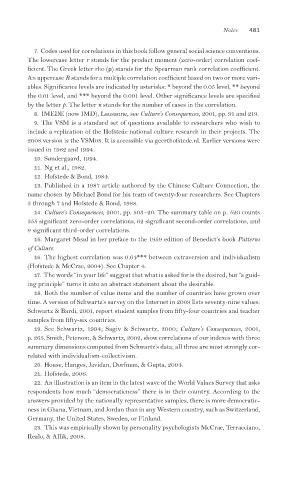Page 516 - Cultures and Organizations
P. 516
Notes 481
7. Codes used for correlations in this book follow general social science conventions.
The lowercase letter r stands for the product moment (zero-order) correlation coef-
fi cient. The Greek letter rho ( ) stands for the Spearman rank correlation coeffi cient.
An uppercase R stands for a multiple correlation coefficient based on two or more vari-
ables. Significance levels are indicated by asterisks: * beyond the 0.05 level, ** beyond
the 0.01 level, and *** beyond the 0.001 level. Other significance levels are specifi ed
by the letter p. The letter n stands for the number of cases in the correlation.
8. IMEDE (now IMD), Lausanne, see Culture’s Consequences, 2001, pp. 91 and 219.
9. The VSM is a standard set of questions available to researchers who wish to
include a replication of the Hofstede national culture research in their projects. The
2008 version is the VSM08. It is accessible via geerthofstede.nl. Earlier versions were
issued in 1982 and 1994.
10. Søndergaard, 1994.
11. Ng et al., 1982.
12. Hofstede & Bond, 1984.
13. Published in a 1987 article authored by the Chinese Culture Connection, the
name chosen by Michael Bond for his team of twenty-four researchers. See Chapters
3 through 7 and Hofstede & Bond, 1988.
14. Culture’s Consequences, 2001, pp. 503–20. The summary table on p. 520 counts
355 significant zero-order correlations, 62 significant second-order correlations, and
9 significant third-order correlations.
15. Margaret Mead in her preface to the 1959 edition of Benedict’s book Patterns
of Culture.
16. The highest correlation was 0.64*** between extraversion and individualism
(Hofstede & McCrae, 2004). See Chapter 4.
17. The words “in your life” suggest that what is asked for is the desired, but “a guid-
ing principle” turns it into an abstract statement about the desirable.
18. Both the number of value items and the number of countries have grown over
time. A version of Schwartz’s survey on the Internet in 2009 lists seventy-nine values.
Schwartz & Bardi, 2001, report student samples from fifty-four countries and teacher
samples from fi fty-six countries.
19. See Schwartz, 1994; Sagiv & Schwartz, 2000; Culture’s Consequences, 2001,
p. 265. Smith, Peterson, & Schwartz, 2002, show correlations of our indexes with three
summary dimensions computed from Schwartz’s data; all three are most strongly cor-
related with individualism-collectivism.
20. House, Hanges, Javidan, Dorfman, & Gupta, 2004.
21. Hofstede, 2006.
22. An illustration is an item in the latest wave of the World Values Survey that asks
respondents how much “democraticness” there is in their country. According to the
answers provided by the nationally representative samples, there is more democratic-
ness in Ghana, Vietnam, and Jordan than in any Western country, such as Switzerland,
Germany, the United States, Sweden, or Finland.
23. This was empirically shown by personality psychologists McCrae, Terracciano,
Realo, & Allik, 2008.

